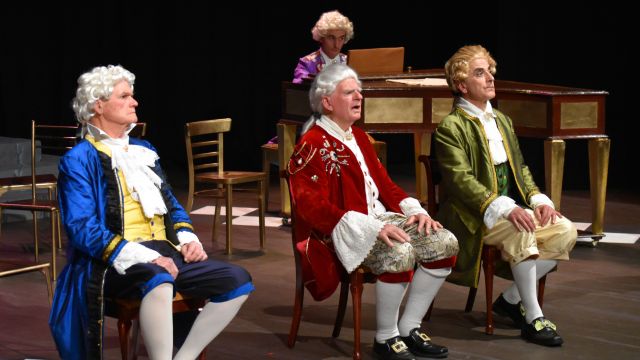Amadeus
Salieri is extremely displeased with God. In fact, he’s furious. God has not honoured their pact. Salieri had vowed to serve God all the days of his life in exchange for becoming a famous musician. Although for some years God had seemed to be fulfilling his side of the bargain, Salieri having been elevated to the esteemed role of Austrian Court Composer with his reputation growing and glowing, God suddenly turned on him by delivering into the world true musical genius in the form of the unutterably unbearable upstart Wolfgang Amadeus Mozart.
Laughed at by his treacherous god, and tortured by Mozart’s transcendent musical perfection, Salieri is left with no alternative but to give rein to his all-consuming jealousy and hatred: God’s unparallelled creation, Mozart, must be destroyed. And in this, Salieri’s efforts and cunning are boundless. But what price may he ultimately be called on to pay?
By far the largest and most challenging role in Amadeus is that of the darkly haunted Salieri. The amount and complexity of his speech alone is staggering. But Jim Adamik mastered every syllable with conviction and aplomb and deliciously brought to the stage the multiple faces of the darkly haunted Salieri: obsequiousness, false friendship, overwhelming jealousy, and true horror at hearing the kind of musical gloriousness that he had hardly dreamt possible. Without one moment of excess, Adamik embraced Salieri’s obsessive loathing and his undermining and undoing of Mozart, finally leading to Salieri to the verge of insanity.

As in the film Amadeus, this Mozart incarnated as an outrageous, self-adoring buffoon, and in this Jack Shanahan excelled. His character giggled and pranced his naughty way throughout, until ill health and extreme poverty took their toll. This over-egged Mozart appears from the jaded point of view of Salieri rather than from a more historically accurate perspective. The Mozart whom Salieri conjures up is almost naïvely imbecilic, thrilled by his own brilliance (though oddly dependent on the good opinion of others), and vulgar. Shanahan perfectly brought this caricature to life, somehow making him sympathetic in spite of his social ineptitude.
REP’s large cast brought the entire story vividly to life. The pompous, entitled members of the Austrian Court are juxtaposed against the wickedly funny gossips Vinticello I and II; Salieri’s vacuous wife stands in contrast to the vivacious, loyal wife of Mozart; and a host of others convincingly fill the roles of courtiers, peasants, and servants.
Costuming was superb. Designed by Deborah Huff-Horwood, and brought into being by very gifted elves, the costumes represented the late 1700s and early 1800s in spectacular colour and decoration. Set design was simple but versatile, with changes of venue shown by movement of furniture and changing images on screen behind the stage.
A special mention regarding the music: as expected, the audience was treated to recordings of snippets from Mozart’s operas and his great requiem. The notes that Salieri and Mozart “performed” were beautifully played recordings by Christine Faron, a specialist in 18th-century keyboard music.
Lighting set the moods, from darkness reflecting the blackness in Salieri’s mind to the bright clamour of court as enlivened by Mozart’s excessive antics and personality.
REP’s Amadeus is captivating in its unravelling of two human beings, in the journey into Salieri’s mind, bitterly twisted by every note of Mozart’s genius.
Michele E. Hawkins.
Images (from top): [front, L–R], David H Bennett, Neil McLeod, Tony Falla, and [back] Jack Shanahan, and below [L–R], Michael J. Smith, Justice-Noah Malfitano, and Jim Adamik, in Amadeus. Photographer: Eve Murray.
Subscribe to our E-Newsletter, buy our latest print edition or find a Performing Arts book at Book Nook.

